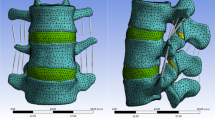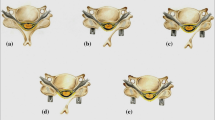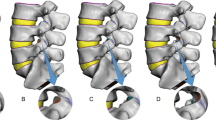Abstract
Purpose
The objective of this study was to investigate the impact of the less invasive procedures of hemilaminectomy and unilateral multilevel interlaminar fenestration (UMIF) on the cervical spinal biomechanics.
Methods
A validated nonlinear finite element model of the intact cervical spine (C2–C7) was modified to study the biomechanical changes as a result of surgical alteration for treatment of intradural tumours at C3–6 using multilevel laminectomy (ML), multilevel hemilaminectomy (MHL) and UMIF with or without unilateral graded facetectomy.
Results
Under the load-controlled method, the greatest biomechanical changes occurred at the surgical segments. The largest increases occurred in flexion motions following ML approach with 70, 62 and 60 % increase at C3–4, C4–5 and C5–6, respectively. The increases were significantly reduced to no more than 14 % under MHL and UMIF. When combined with graded facetectomy, the changes in flexion under ML approach have a significantly further increase, up to 110 % at C3–4. The further increase was not significantly following MHL and UMIF, with no more than 31 % increase at C3–4, C4–5 and C5–6. The motion following UMIF was only slightly smaller in axial rotation than MHL. The maximum stresses in the annulus occurred during flexion in ML model, with 39, 34 and 38 % more stress than the intact at C3–4, C4–5 and C5–6, respectively. The increases of stress were significantly reduced to 5–7 % under MHL and UMIF.
Conclusions
The less invasive approaches of UMIF and MHL greatly preserved the flexion motion (more than 48 %) of the cervical spine compared with laminectomy, and the preserved motion mean the low-risk of postoperative spinal instability. UMIF and MHL also reduced the increased stress of annulus caused by ML, and the lesser stress will lower the risk of postoperative disc degeneration. The posterior bone elements play a slight role in spinal stability after removal of the attached ligaments.










Similar content being viewed by others
Reference
de Jonge T, Slullitel H, Dubousset J et al (2005) Late-onset spinal deformities in children treated by laminectomy and radiation therapy for malignant tumours. Eur Spine J 14:765–771
Yao KC, McGirt MJ, Chaichana KL et al (2007) Risk factors for progressive spinal deformity following resection of intramedullary spinal cord tumors in children: an analysis of 161 consecutive cases. J Neurosurg 107(6 Suppl):463–468
Yeh JS, Sgouros S, Walsh AR et al (2001) Spinal sagittal malalignment following surgery for primary intramedullary tumours in children. Pediatr Neurosurg 35:318–324
Asazuma T, Nakamura M, Matsumoto M et al (2004) Postoperative changes of spinal curvature and range of motion in adult patients with cervical spinal cord tumors: analysis of 51 cases and review of the literature. J Spinal Disord Tech 17:178–182
Chiou SM, Eggert HR, Laborde G et al (1989) Microsurgical unilateral approaches for spinal tumour surgery: eight years’ experience in 256 primary operated patients. Acta Neurochir 100:127–133
Naganawa T, Miyamoto K, Hosoe H et al (2011) Hemilaminectomy for removal of extramedullary or extradural spinal cord tumors: medium to long-term clinical outcomes. Yonsei Med J 52:121–129
Yaşargil MG, Tranmer BI, Adamson TE et al (1991) Unilateral partial hemi-laminectomy for the removal of extra- and intramedullary tumours and AVMs. Adv Tech Stand Neurosurg 18:113–132
Ogden AT, Bresnahan L, Smith JS et al (2009) Biomechanical comparison of traditional and minimally invasive intradural tumor exposures using finite element analysis. Clin Biomech 24:143–147
Yasuoka S, Peterson HA, MacCarty CS (1982) Incidence of spinal column deformity after multilevel laminectomy in children and adults. J Neurosurg 57:441–445
Koch-Wiewrodt D, Wagner W, Perneczky A (2007) Unilateral multilevel interlaminar fenestration instead of laminectomy or hemilaminectomy: an alternative surgical approach to intraspinal space-occupying lesions. J Neurosurg Spine 6:485–492
Raynor RB, Pugh J, Shapiro I (1985) Cervical facetectomy and its effect on spine strength. J Neurosurg 63:278–282
Zdeblick TA, Abitbol JJ, Kunz DN et al (1993) Cervical stability after sequential capsule resection. Spine 18:2005–2008
Katsumi Y, Honma T, Nakamura T (1989) Analysis of cervical instability resulting from laminectomies for removal of spinal cord tumor. Spine 14:1171–1176
Silva MJ, Wang C, Keaveny TM et al (1994) Direct and computed tomography thickness measurements of the human, lumbar vertebral shell and endplate. Bone 15:409–514
Edwards WT, Zheng Y, Ferrara LA et al (2001) Structural features and thickness of the vertebral cortex in the thoracolumbar spine. Spine 26:218–225
Panjabi MM, Chen NC, Shin EK et al (2001) The cortical shell architecture of human cervical vertebral bodies. Spine 26:2478–2484
Ha SK (2006) Finite element modeling of multi-level cervical spinal segments (C3-C6) and biomechanical analysis of an elastomer-type prosthetic disc. Med Eng Phys 28:534–541
Hong-Wan N, Ee-Chon T, Qing-Hang Z (2004) Biomechanical effects of C2-C7 intersegmental stability due to laminectomy with unilateral and bilateral facetectomy. Spine 29:1737–1745 discussion 1746
Lee SH, Im YJ, Kim KT et al (2011) Comparison of cervical spine biomechanics after fixed- and mobile-core artificial disc replacement: a finite element analysis. Spine 36:700–708
Yoganandan N, Kumaresan S, Pintar FA (2001) Biomechanics of the cervical spine Part 2. Cervical spine soft tissue responses and biomechanical modeling. Clin Biomech 16:1–27
Goel VK, Clausen JD (1998) Prediction of load sharing among spinal components of a C5-C6 motion segment using the finite element approach. Spine 23:684–691
Clausen JD, Goel VK, Traynelis VC et al (1997) Uncinate processes and Luschka joints influence the biomechanics of the cervical spine: quantification using a finite element model of the C5-C6 segment. J Orthop Res 15:342–347
Yoganandan N, Kumaresan S, Pintar FA (2000) Geometric and mechanical properties of human cervical spine ligaments. J Biomech Eng 122:623–629
Wheeldon JA, Pintar FA, Knowles S et al (2006) Experimental flexion/extension data corridors for validation of finite element models of the young, normal cervical spine. J Biomech 39:375–380
Panjabi MM, Crisco JJ, Vasavada A et al (2001) Mechanical properties of the human cervical spine as shown by three-dimensional load-displacement curves. Spine 26:2692–2700
Zhang QH, Teo EC, Ng HW et al (2006) Finite element analysis of moment-rotation relationships for human cervical spine. J Biomech 39:189–193
Cusick JF, Pintar FA, Yoganandan N (1995) Biomechanical alterations induced by multilevel cervical laminectomy. Spine 20:2392–2398 discussion 2398-2399
Panjabi MM (2007) Hybrid multidirectional test method to evaluate spinal adjacent-level effects. Clin Biomech (Bristol, Avon) 22:257–265
Zhong ZC, Chen SH, Hung CH (2009) Load- and displacement-controlled finite element analyses on fusion and non-fusion spinal implants. Proc Inst Mech Eng H 223:143–157
Kaptain GJ, Simmons NE, Replogle RE et al (2000) Incidence and outcome of kyphotic deformity following laminectomy for cervical spondylotic myelopathy. J Neurosurg 93(2 Suppl):199–204
Caspar W, Papavero L, Sayler MK et al (1994) Precise and limited decompression for lumbar spinal stenosis. Acta Neurochir 131:130–136
Manzano GR, Casella G, Wang MY et al (2012) A prospective, randomized trial comparing expansile cervical laminoplasty and cervical laminectomy and fusion for multilevel cervical myelopathy. Neurosurgery 70:264–277
Nolan JP Jr, Sherk HH (1988) Biomechanical evaluation of the extensor musculature of the cervical spine. Spine 13:9–11
Acknowledgments
The authors received no financial support for conducting this study or publication of the findings.
Conflict of interest
No benefits in any form have been or will be received from a commercial party related directly or indirectly to the subject of this manuscript.
Author information
Authors and Affiliations
Corresponding authors
Additional information
T. Xie and J. Qian contributed equally to this manuscript.
The manuscript submitted does not contain information about medical device(s)/drug(s).
Rights and permissions
About this article
Cite this article
Xie, T., Qian, J., Lu, Y. et al. Biomechanical comparison of laminectomy, hemilaminectomy and a new minimally invasive approach in the surgical treatment of multilevel cervical intradural tumour: a finite element analysis. Eur Spine J 22, 2719–2730 (2013). https://doi.org/10.1007/s00586-013-2992-1
Received:
Revised:
Accepted:
Published:
Issue Date:
DOI: https://doi.org/10.1007/s00586-013-2992-1




